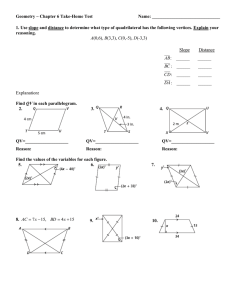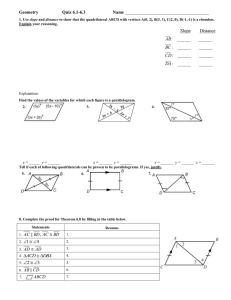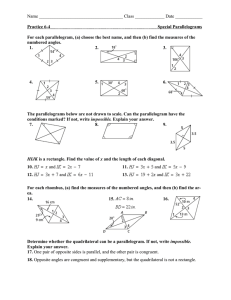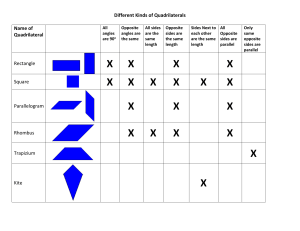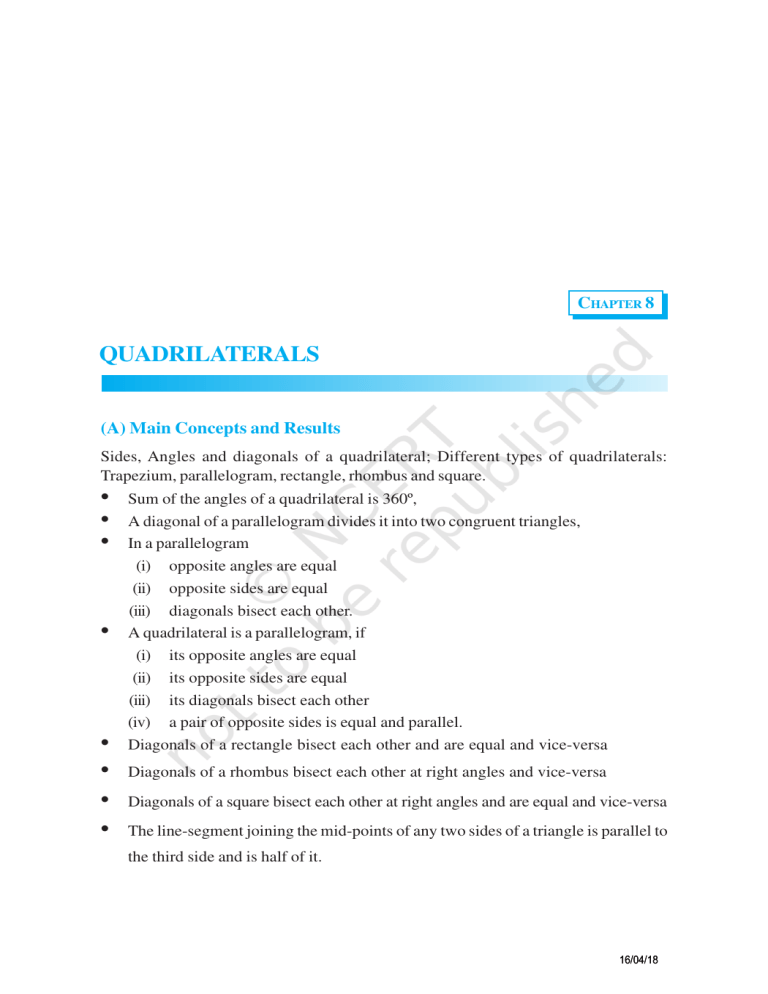
CHAPTER 8 QUADRILATERALS (A) Main Concepts and Results Sides, Angles and diagonals of a quadrilateral; Different types of quadrilaterals: Trapezium, parallelogram, rectangle, rhombus and square. • Sum of the angles of a quadrilateral is 360º, • A diagonal of a parallelogram divides it into two congruent triangles, • In a parallelogram (i) opposite angles are equal (ii) opposite sides are equal (iii) diagonals bisect each other. • A quadrilateral is a parallelogram, if (i) its opposite angles are equal (ii) its opposite sides are equal (iii) its diagonals bisect each other (iv) a pair of opposite sides is equal and parallel. • Diagonals of a rectangle bisect each other and are equal and vice-versa • • • Diagonals of a rhombus bisect each other at right angles and vice-versa Diagonals of a square bisect each other at right angles and are equal and vice-versa The line-segment joining the mid-points of any two sides of a triangle is parallel to the third side and is half of it. 16/04/18 QUADRILATERALS • • 73 A line drawn through the mid-point of a side of a triangle parallel to another side bisects the third side, The quadrilateral formed by joining the mid-points of the sides of a quadrilateral, taken in order, is a parallelogram. (B) Multiple Choice Questions Write the correct answer : Sample Question 1 : Diagonals of a parallelogram ABCD intersect at O. If ∠BOC = 90º and ∠BDC = 50º, then ∠OAB is (A) 90º (B) 50º (C) 40º (D) 10º Solution : Answer (C) EXERCISE 8.1 Write the correct answer in each of the following: 1. Three angles of a quadrilateral are 75º, 90º and 75º. The fourth angle is (A) 90º (B) 95º (C) 105º (D) 120º 2. A diagonal of a rectangle is inclined to one side of the rectangle at 25º. The acute angle between the diagonals is (A) 55º (B) 50º (C) 40º (D) 25º 3. ABCD is a rhombus such that ∠ACB = 40º. Then ∠ADB is (A) 40º (B) 45º (C) 50º (D) 60º 4. The quadrilateral formed by joining the mid-points of the sides of a quadrilateral PQRS, taken in order, is a rectangle, if (A) PQRS is a rectangle (B) PQRS is a parallelogram (C) diagonals of PQRS are perpendicular (D) diagonals of PQRS are equal. 5. The quadrilateral formed by joining the mid-points of the sides of a quadrilateral PQRS, taken in order, is a rhombus, if (A) PQRS is a rhombus (B) PQRS is a parallelogram (C) diagonals of PQRS are perpendicular (D) diagonals of PQRS are equal. 16/04/18 74 EXEMPLAR PROBLEMS 6. If angles A, B, C and D of the quadrilateral ABCD, taken in order, are in the ratio 3:7:6:4, then ABCD is a (A) rhombus (B) parallelogram (C) trapezium (D) kite 7. If bisectors of ∠A and ∠B of a quadrilateral ABCD intersect each other at P, of ∠B and ∠C at Q, of ∠C and ∠D at R and of ∠D and ∠A at S, then PQRS is a (A) rectangle (B) rhombus (C) parallelogram (D) quadrilateral whose opposite angles are supplementary 8. If APB and CQD are two parallel lines, then the bisectors of the angles APQ, BPQ, CQP and PQD form (A) a square (B) a rhombus (C) a rectangle (D) any other parallelogram 9. The figure obtained by joining the mid-points of the sides of a rhombus, taken in order, is (A) a rhombus (B) a rectangle (C) a square (D) any parallelogram 10. D and E are the mid-points of the sides AB and AC of ∆ABC and O is any point on side BC. O is joined to A. If P and Q are the mid-points of OB and OC respectively, then DEQP is (A) a square (B) a rectangle (C) a rhombus (D) a parallelogram 11. The figure formed by joining the mid-points of the sides of a quadrilateral ABCD, taken in order, is a square only if, (A) ABCD is a rhombus (B) diagonals of ABCD are equal (C) diagonals of ABCD are equal and perpendicular (D) diagonals of ABCD are perpendicular. 12. The diagonals AC and BD of a parallelogram ABCD intersect each other at the point O. If ∠DAC = 32º and ∠AOB = 70º, then ∠DBC is equal to (A) 24º (B) 86º (C) 38º (D) 32º 13. Which of the following is not true for a parallelogram? (A) opposite sides are equal (B) opposite angles are equal (C) opposite angles are bisected by the diagonals (D) diagonals bisect each other. 16/04/18 QUADRILATERALS 75 14. D and E are the mid-points of the sides AB and AC respectively of ∆ABC. DE is produced to F. To prove that CF is equal and parallel to DA, we need an additional information which is (A) ∠DAE = ∠EFC (B) AE = EF (C) DE = EF (D) ∠ADE = ∠ECF. (C) Short Answer Questions with Reasoning Sample Question 1 : ABCD is a parallelogram. If its diagonals are equal, then find the value of ∠ABC. Solution : As diagonals of the parallelogram ABCD are equal, it is a rectangle. Therefore, ∠ABC = 90º Sample Question 2 : Diagonals of a rhombus are equal and perpendicular to each other. Is this statement true? Give reason for your answer. Solution : This statement is false, because diagonals of a rhombus are perpendicular but not equal to each other. Sample Question 3 : Three angles of a quadrilateral ABCD are equal. Is it a parallelogram? Why or why not? Solution: It need not be a parallelogram, because we may have ∠A = ∠B = ∠C = 80º and ∠D = 120º. Here, ∠B ≠ ∠D. Sample Question 4 : Diagonals AC and BD of a quadrilateral ABCD intersect each other at O such that OA : OC = 3: 2. Is ABCD a parallelogram? Why or why not? Solution : ABCD is not a parallelogram, because diagonals of a parallelogram bisect each other. Here OA ≠ OC. EXERCISE 8.2 1. Diagonals AC and BD of a parallelogram ABCD intersect each other at O. If OA = 3 cm and OD = 2 cm, determine the lengths of AC and BD. 2. Diagonals of a parallelogram are perpendicular to each other. Is this statement true? Give reason for your answer. 3. Can the angles 110º, 80º, 70º and 95º be the angles of a quadrilateral? Why or why not? 16/04/18 76 EXEMPLAR PROBLEMS 4. In quadrilateral ABCD, ∠A + ∠D = 180º. What special name can be given to this quadrilateral? 5. All the angles of a quadrilateral are equal. What special name is given to this quadrilateral? 6. Diagonals of a rectangle are equal and perpendicular. Is this statement true? Give reason for your answer. 7. Can all the four angles of a quadrilateral be obtuse angles? Give reason for your answer. 8. In ∆ABC, AB = 5 cm, BC = 8 cm and CA = 7 cm. If D and E are respectively the mid-points of AB and BC, determine the length of DE. 9. In Fig.8.1, it is given that BDEF and FDCE are parallelograms. Can you say that BD = CD? Why or why not? Fig. 8.1 10. In Fig.8.2, ABCD and AEFG are two parallelograms. If ∠C = 55º, determine ∠F. 11. Can all the angles of a quadrilateral be acute angles? Give reason for your answer. 12. Can all the angles of a quadrilateral be right angles? Give reason for your answer. 13. Diagonals of a quadrilateral ABCD bisect each other. If ∠A = 35º, determine ∠B. Fig. 8.2 16/04/18 QUADRILATERALS 77 14. Opposite angles of a quadrilateral ABCD are equal. If AB = 4 cm, determine CD. (D) Short Answer Questions Sample Question 1 : Angles of a quadrilateral are in the ratio 3 : 4 : 4 : 7. Find all the angles of the quadrilateral. Solution : Let the angles of the quadrilateral be 3x, 4x, 4x and 7x. So, 3x + 4x + 4x + 7x = 360º or 18x = 360º, i.e., x = 20º Thus, required angles are 60º, 80º, 80º and 140º. Sample Question 2 : In Fig.8.3, X and Y are respectively the mid-points of the opposite sides AD and BC of a parallelogram ABCD. Also, BX and DY intersect AC at P and Q, respectively. Show that AP = PQ = QC. Solution : AD = BC Fig. 8.3 (Opposite sides of a parallelogram) Therefore, = DX = BY ( 1 AD 2 1 BC) 2 Also, DX || BY (As AD || BC) So, XBYD is a parallelogram (A pair of opposite sides equal and parallel) i.e., PX || QD Therefore, AP = PQ (From ∆AQD where X is mid-point of AD) Similarly, from ∆CPB, CQ = PQ (1) Thus, AP = PQ = CQ [From (1) and (2)] (2) Sample Question 3 : In Fig.8.4, AX and CY are respectively the bisectors of the opposite angles A and C of a parallelogram ABCD. Show that AX || CY. Fig. 8.4 16/04/18 78 EXEMPLAR PROBLEMS Solution : ∠A = ∠C (Opposite angles of parallelogram ABCD) Therefore, 1 1 ∠A = ∠C 2 2 i.e., ∠YAX = ∠YCX (1) Also, ∠AYC + ∠YCX = 180º (Because YA || CX) (2) Therefore, ∠AYC + ∠YAX = 180º [From (1) and (2)] So, AX || CY (As interior angles on the same side of the transversal are supplementary) EXERCISE 8.3 1. One angle of a quadrilateral is of 108º and the remaining three angles are equal. Find each of the three equal angles. 2. ABCD is a trapezium in which AB || DC and ∠A = ∠B = 45º. Find angles C and D of the trapezium. 3. The angle between two altitudes of a parallelogram through the vertex of an obtuse angle of the parallelogram is 60º. Find the angles of the parallelogram. 4. ABCD is a rhombus in which altitude from D to side AB bisects AB. Find the angles of the rhombus. 5. E and F are points on diagonal AC of a parallelogram ABCD such that AE = CF. Show that BFDE is a parallelogram. 6. E is the mid-point of the side AD of the trapezium ABCD with AB || DC. A line through E drawn parallel to AB intersect BC at F. Show that F is the mid-point of BC. [Hint: Join AC] 7. Through A, B and C, lines RQ, PR and QP have been drawn, respectively parallel to sides BC, CA and AB of a ∆ ABC as shown in Fig.8.5. Show that BC = 1 QR. 2 8. D, E and F are the mid-points of the sides BC, CA and AB, respectively of an Fig. 8.5 16/04/18 QUADRILATERALS 79 equilateral triangle ABC. Show that ∆ DEF is also an equilateral triangle. 9. Points P and Q have been taken on opposite sides AB and CD, respectively of a parallelogram ABCD such that AP = CQ (Fig. 8.6). Show that AC and PQ bisect each other. Fig. 8.6 10. In Fig. 8.7, P is the mid-point of side BC of a parallelogram ABCD such that ∠BAP = ∠DAP. Prove that AD = 2CD. Fig. 8.7 (E) Long Answer Questions Sample Question 1 : PQ and RS are two equal and parallel line-segments. Any point M not lying on PQ or RS is joined to Q and S and lines through P parallel to QM and through R parallel to SM meet at N. Prove that line segments MN and PQ are equal and parallel to each other. Solution : We draw the figure as per the given conditions (Fig.8.8). Fig. 8.8 16/04/18 80 EXEMPLAR PROBLEMS It is given that PQ = RS and PQ || RS. Therefore, PQSR is a parallelogram. So, PR = QS and PR || QS (1) Now, PR || QS Therefore, ∠RPQ + ∠PQS = 180º (Interior angles on the same side of the transversal) i.e., ∠RPQ + ∠PQM + ∠MQS = 180º (2) Also, PN || QM (By construction) Therefore, ∠NPQ + ∠PQM = 180º i.e., ∠NPR + ∠RPQ + ∠PQM = 180º (3) So, ∠NPR = ∠MQS [From (2) and (3)] (4) Similarly, ∠NRP = ∠MSQ (5) Therefore, ∆PNR ≅ ∆QMS [ASA, using (1), (4) and (5)] So, PN = QM and NR = MS (CPCT) As, PN = QM and PN || QM, we have PQMN is a parallelogram So, MN = PQ and NM || PQ. Sample Question 2 : Prove that a diagonal of a parallelogram divides it into two congruent triangles. Solution : See proof of Theorem 8.1 in the textbook. Sample Question 3 : Show that the quadrilateral formed by joining the mid-points the sides of a rhombus, taken in order, form a rectangle. Solution : Let ABCD be a rhombus and P, Q, R and S be the mid-points of sides AB, BC, CD and DA, respectively (Fig. 8.9). Join AC and BD. Fig. 8.9 16/04/18 QUADRILATERALS 81 From triangle ABD, we have SP = 1 BD and 2 SP || BD (Because S and P are mid-points) Similarly, RQ = 1 BD and RQ || BD 2 Therefore, SP = RQ and SP || RQ So, PQRS is a parallelogram. (1) Also,AC ⊥ BD (Diagonals of a rhombus are perpendicular) Further PQ || AC (From ∆BAC) As SP || BD, PQ || AC and AC ⊥ BD, therefore, we have SP ⊥ PQ, i.e. ∠SPQ = 90º. (2) Therefore, PQRS is a rectangle[From (1) and (2)] Sample Question 4 : A diagonal of a parallelogram bisects one of its angle. Prove that it will bisect its opposite angle also. Solution : Let us draw the figure as per given condition (Fig.8.10). In it, AC is a diagonal which bisects ∠BAD of the parallelogram ABCD, i.e., it is given that ∠BAC = ∠DAC. We need to prove that ∠BCA = ∠DCA. AB || CD and AC is a transversal. Therefore, ∠BAC = ∠DCA (Alternate angles) (1) Similarly, ∠DAC = ∠BCA (From AD || BC) (2) But it is given that ∠BAC = ∠DAC (3) Therefore, from (1), (2) and (3), we have ∠BCA = ∠DCA Fig. 8.10 16/04/18 82 EXEMPLAR PROBLEMS EXERCISE 8.4 1. A square is inscribed in an isosceles right triangle so that the square and the triangle have one angle common. Show that the vertex of the square opposite the vertex of the common angle bisects the hypotenuse. 2. In a parallelogram ABCD, AB = 10 cm and AD = 6 cm. The bisector of ∠A meets DC in E. AE and BC produced meet at F. Find the length of CF. 3. P, Q, R and S are respectively the mid-points of the sides AB, BC, CD and DA of a quadrilateral ABCD in which AC = BD. Prove that PQRS is a rhombus. 4. P, Q, R and S are respectively the mid-points of the sides AB, BC, CD and DA of a quadrilateral ABCD such that AC ⊥ BD. Prove that PQRS is a rectangle. 5. P, Q, R and S are respectively the mid-points of sides AB, BC, CD and DA of quadrilateral ABCD in which AC = BD and AC ⊥ BD. Prove that PQRS is a square. 6. A diagonal of a parallelogram bisects one of its angles. Show that it is a rhombus. 7. P and Q are the mid-points of the opposite sides AB and CD of a parallelogram ABCD. AQ intersects DP at S and BQ intersects CP at R. Show that PRQS is a parallelogram. 8. ABCD is a quadrilateral in which AB || DC and AD = BC. Prove that ∠A = ∠B and ∠C = ∠D. 9. In Fig. 8.11, AB || DE, AB = DE, AC || DF and AC = DF. Prove that BC || EF and BC = EF. Fig. 8.11 10. E is the mid-point of a median AD of ∆ABC and BE is produced to meet AC at F. Show that AF = 1 AC. 3 11. Show that the quadrilateral formed by joining the mid-points of the consecutive sides of a square is also a square. 16/04/18 QUADRILATERALS 83 12. E and F are respectively the mid-points of the non-parallel sides AD and BC of a trapezium ABCD. Prove that EF || AB and EF = 1 (AB + CD). 2 [Hint: Join BE and produce it to meet CD produced at G.] 13. Prove that the quadrilateral formed by the bisectors of the angles of a parallelogram is a rectangle. 14. P and Q are points on opposite sides AD and BC of a parallelogram ABCD such that PQ passes through the point of intersection O of its diagonals AC and BD. Show that PQ is bisected at O. 15. ABCD is a rectangle in which diagonal BD bisects ∠B. Show that ABCD is a square. 16. D, E and F are respectively the mid-points of the sides AB, BC and CA of a triangle ABC. Prove that by joining these mid-points D, E and F, the triangles ABC is divided into four congruent triangles. 17. Prove that the line joining the mid-points of the diagonals of a trapezium is parallel to the parallel sides of the trapezium. 18. P is the mid-point of the side CD of a parallelogram ABCD. A line through C parallel to PA intersects AB at Q and DA produced at R. Prove that DA = AR and CQ = QR. 16/04/18
